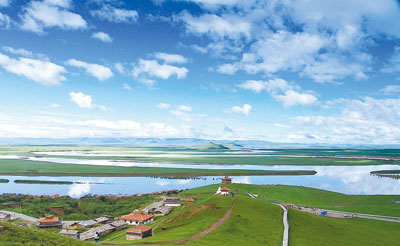
ABA Tibetan and Qiang Autonomous Prefecture is situated in northwestern Sichuan Province at the eastern end of the Qinghai-Tibet Plateau. This area is more than just the Jiuzhai Valley and Huanglong. Here are some stunning places in the area that are not very well-known to the public. The Nuo’ergai Wetland The Nuo’ergai Wetland, bordering Sichuan and Gansu provinces, is regarded as the third largest prairie in China. The wetland area covers an area of 240,000 hectares. Known as a plateau wetland that is not only the largest but also the best-preserved in the world, it is renowned as “the most beautiful wetland in China” with a unique and charming natural landscape. The main draws here are the grasslands and traditional Tibetan culture. The first turning of the nine Yellow River Turnings, the Baxi Meeting Site, the Ancient Panzhou Ruins and the Mamuo Gorges with green mountains and strange stones are famous scenes to visit on the wetland. Now to September is the best time to view wildflowers on the wetland. You can spend your time enjoying the fantastic scenery and ride a horse across the vast wetland. Temperatures in the area are very cold all year round. The average annual temperatures there are from 0 to 2 degrees Celsius. Be sure to take a coat with you! Transport: Fly to Chengdu from Shenzhen airport, and take a coach to the wetland from Chengdu. When in the wetland area, you can access various areas by renting a car. Miyaluo Located in Li County of Aba, Miyaluo is one of the most famous places for viewing red leaves in China, as it is the largest and also the most spectacular maple scenic spot in China with an area over 180 times that of Fragrant Hill in Beijing. The name “Miyaluo” means “amusing valley” in Tibetan. Covering an area of 3,690 square kilometers, the area is decorated with maples, birch trees, snow-capped mountains, bubbling hot springs and magnificent waterfalls. When autumn comes, the area is transformed into a fairyland with eye-catching red leaves, a tranquil blue sky, white clouds, quiet valleys and gurgling creeks. In addition to enjoying the abundant natural beauty, you can also visit local residents to experience the unique cultures of the Tibet and Qiang ethnic groups. There are many ancient villages featuring unique residential houses and fortresses in the area that were built along the mountains. The quiet and peaceful ethnic scenes are a favorite for professional photographers. Average temperatures in the area are also not high, so it is better to bring a coat and sweater even in the summertime. Transport: Fly to Chengdu from Shenzhen airport, and take a coach to the area. Rangtang’s temples Rangtang’s temples, all located in Rangtang County, are the top three temples for the Jonangpa School of Tibetan Buddhism. Founded in 1294, the Jonangpa School is a unique school within Tibetan Buddhism and was extremely popular in the region during the Yuan Dynasty (1279-1368). As it holds opposite belief from the Gelug School, the ruling school of Tibetan Buddhism, it was expelled by the Gelug School to this isolated area. Nowadays, the ancient Buddhist school can only be found in remote areas in Aba and Guoluo, Qinghai Province. The main attractions in Rangtang are its three temples. Among them, Cuo’erji Temple is the only Tibetan-style architecture built in the Song Dynasty (960-1279) in Sichuan Province. Its unique structure and special customs can hardly be seen in other parts of the world. Local traditions are another highlight of Rangtang, as most locals still live an ancient and religious lifestyle. It is highly recommended to stay at local inns to experience special delicacies and customs. The area’s rainy season is from June to September, and most villages and temples cannot be reached during this period. Transport: Fly to Chengdu from Shenzhen airport and take a coach to Rangtang.(Wang Yuanyuan) | 
